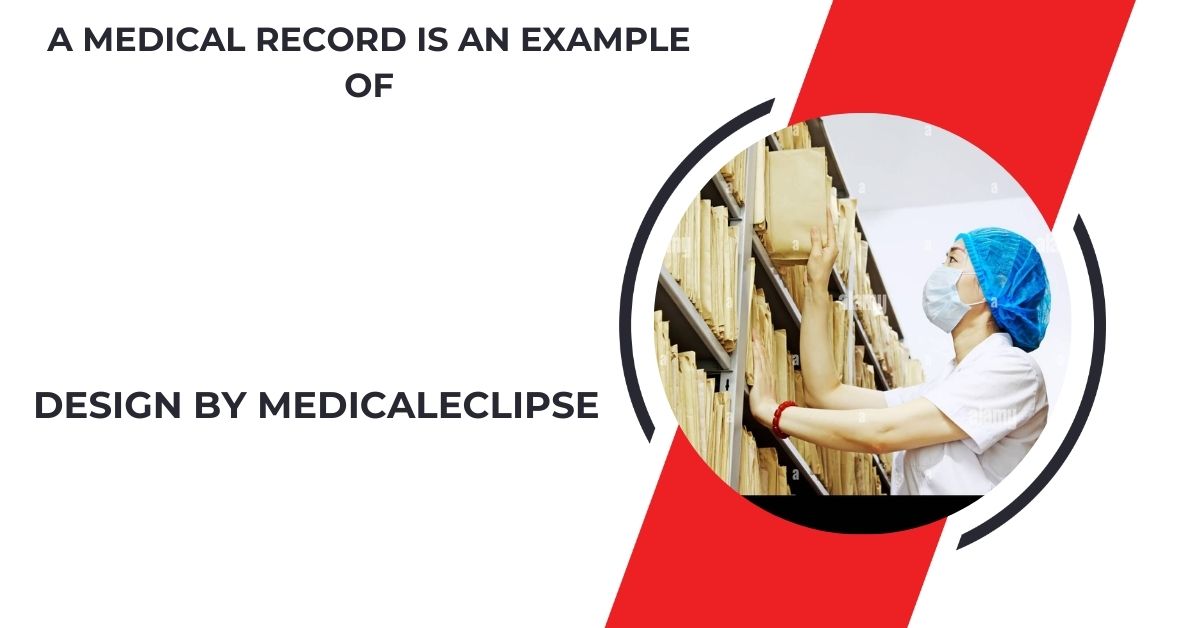A medical record is a crucial document detailing a patient’s health history, including identification, medical history, and treatment plans. It supports patient care and clinical decisions.
This article delves into the intricate components of medical records, offering examples of their multifaceted nature and underscoring their significance in delivering effective healthcare.
A Medical Record Is an Example Of:

Introduction:
In the realm of healthcare, medical records stand as foundational documents that chronicle the entire trajectory of a patient’s health journey. These records encapsulate not just the medical history but also the patient’s interactions with the healthcare system, encompassing treatments, observations, and outcomes. Medical records are more than mere repositories of information; they are dynamic tools that enhance patient care, support clinical decision-making, and ensure regulatory compliance.
Patient Identification Information:
The cornerstone of a medical record lies in the patient identification section, which is paramount for establishing the identity of individuals seeking care. This section typically includes:
- Full Name: The first and last name of the patient, essential for identification and record-keeping.
- Date of Birth: This helps verify the patient’s age and is critical for differentiating between patients with similar names.
- Contact Information: This includes current addresses, telephone numbers, and email addresses, which are vital for communication regarding appointments, test results, and treatment plans.
- Social Security Number (SSN): In some cases, this is included for unique identification, especially for insurance and billing purposes.
- Insurance Information: Details about the patient’s health insurance provider, policy number, and coverage details are crucial for billing and claims processing.
Having accurate patient identification is essential for avoiding medical errors, ensuring that the right patient receives the right treatment, and streamlining the administrative aspects of healthcare delivery.
Medical History:
The medical history section serves as a detailed account of the patient’s past health experiences, laying the groundwork for understanding their current health status. This includes:
- Previous Illnesses: Documentation of any significant past illnesses or conditions, such as diabetes, hypertension, or cancer, allows healthcare providers to assess risks and tailor treatment plans.
- Surgeries and Procedures: A record of past surgical interventions, including dates and outcomes, is vital for understanding potential complications in future treatments.
- Family Medical History: This provides insight into hereditary conditions, such as heart disease or certain cancers, which can inform preventive strategies and screenings.
- Medications: A comprehensive list of past and current medications, including dosages and reasons for discontinuation, is essential for avoiding drug interactions and ensuring continuity of care.
- Allergies: Detailed information about known allergies to medications, foods, or environmental factors is critical to prevent adverse reactions during treatment.
By compiling a thorough medical history, healthcare providers can make informed decisions about diagnosis and treatment, reducing the risk of complications and improving patient outcomes.
Also Read: Frank Rubin Attorney Medical Issues – Frank Rubin Attorney!
Clinical Findings and Observations:
This section captures the objective data gathered during medical evaluations and is crucial for monitoring a patient’s health over time. It includes:
- Vital Signs: Measurements such as blood pressure, heart rate, respiratory rate, and temperature provide essential information about the patient’s immediate health status and help detect potential issues early.
- Physical Examination Notes: Documentation of the healthcare provider’s observations during the physical examination, including findings related to various body systems, helps in identifying abnormalities and planning further diagnostic workup.
- Laboratory Test Results: Detailed results from blood tests, urine tests, and other diagnostic studies provide quantitative data critical for making accurate diagnoses.
- Radiology Reports: Interpretations of imaging studies (X-rays, MRIs, CT scans) that reveal structural abnormalities or disease processes are key to forming a comprehensive clinical picture.
By systematically documenting clinical findings and observations, medical records serve as a foundation for ongoing patient assessment and treatment adjustments.
Treatment Plans:

The treatment plan is a crucial aspect of the medical record, outlining the strategic approach to managing the patient’s health condition. This section may encompass:
- Medications: A detailed list of prescribed medications, including dosages, administration routes, and schedules, is critical for safe and effective treatment.
- Therapies: Recommendations for physical therapy, occupational therapy, psychotherapy, or other rehabilitative services are essential for supporting patient recovery and improving functionality.
- Surgical Procedures: Documentation of any surgical interventions, including indications, procedural details, and expected outcomes, ensures that all healthcare providers are informed and aligned regarding the patient’s care.
- Lifestyle Modifications: Recommendations for diet, exercise, and other lifestyle changes to support health improvement and disease management are also included.
An effective treatment plan is integral to achieving positive health outcomes and ensures that all members of the healthcare team are aware of the patient’s care strategy.
Progress Notes:
Progress notes are dynamic entries made by healthcare providers that document the patient’s ongoing treatment and response to interventions. This section includes:
- Updates on Treatment Effectiveness: Continuous monitoring of how well a patient is responding to treatment protocols, including medication efficacy and therapy progress.
- Changes in Condition: Notations regarding any new symptoms or complications that arise during treatment, allowing for timely intervention if necessary.
- Follow-Up Plans: Recommendations for future evaluations, including scheduled appointments, additional tests, or referrals to specialists, to ensure ongoing care continuity.
Progress notes play a critical role in facilitating communication among healthcare providers and ensuring that all team members are informed about the patient’s evolving condition and care needs.
Also Read: Urgen Care That Is Open And Take Medicaid Greenville Sc – Medicaid Urgent Care Greenville!
Consent Forms:
Informed consent is a legal and ethical cornerstone of medical practice, and consent forms are essential components of medical records. They typically cover:
- Treatment Risks and Benefits: Detailed information about potential risks, benefits, and alternatives to proposed treatments or procedures, ensuring patients are fully informed before agreeing to care.
- Privacy Rights: Documentation of the patient’s rights regarding the confidentiality of their medical information, in compliance with regulations such as the Health Insurance Portability and Accountability Act (HIPAA).
- Research Participation: If applicable, consent forms for the use of patient data in clinical research, ensuring that patients understand their involvement and any associated risks.
Consent forms are essential not only for legal protection but also for building trust between patients and healthcare providers, ensuring that patients are active participants in their care decisions.
Discharge Summaries:
When a patient is discharged from a healthcare facility, a discharge summary is created to provide a comprehensive overview of their care during hospitalization. This document typically includes:
- Reason for Admission: A clear explanation of the medical issue that necessitated the patient’s stay in the facility, serving as context for the treatment provided.
- Summary of Treatment Provided: An overview of the interventions and therapies administered during the hospitalization, including any complications that arose and how they were addressed.
- Post-Discharge Instructions: Detailed guidance on follow-up care, including prescribed medications, warning signs for complications, and recommendations for lifestyle changes or rehabilitation services.
Discharge summaries are crucial for ensuring a smooth transition from hospital to home, providing patients with the information needed to continue their recovery and preventing readmissions.
FAQ’s
1. What is a medical record?
A medical record is a comprehensive document that details a patient’s health history, including identification, medical history, and treatment plans.
2. Why are medical records important?
They support patient care, enhance communication among healthcare providers, and aid in clinical decision-making.
3. What information is included in patient identification?
Patient identification includes the full name, date of birth, contact information, social security number, and insurance details.
4. What are progress notes?
Progress notes are entries made by healthcare providers documenting a patient’s ongoing treatment, responses, and any changes in condition.
5. What do discharge summaries provide?
Discharge summaries offer an overview of the patient’s care during hospitalization, including the reason for admission and post-discharge instructions.
Conclusion
In summary, medical records are essential tools that capture a patient’s health journey, encompassing identification details, medical history, clinical findings, treatment plans, and more. They facilitate effective communication among healthcare providers and empower patients in their care. Understanding the importance of these records enhances patient engagement and ultimately leads to improved health outcomes and safer healthcare experiences.

Leave a Reply